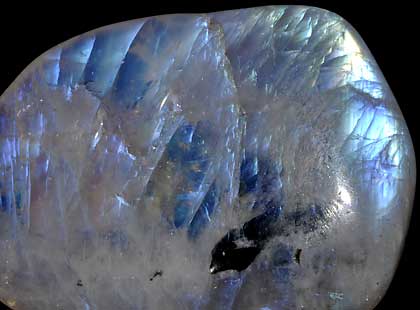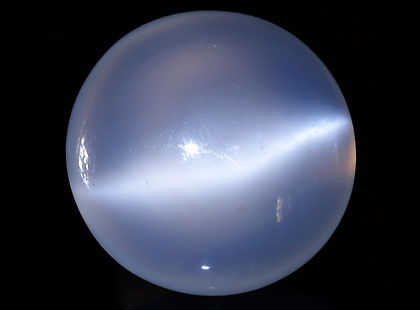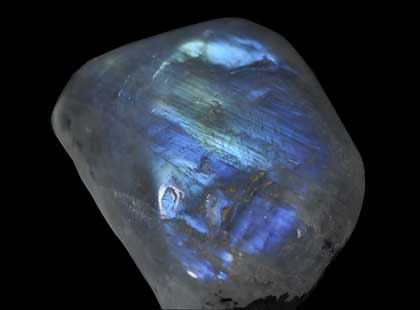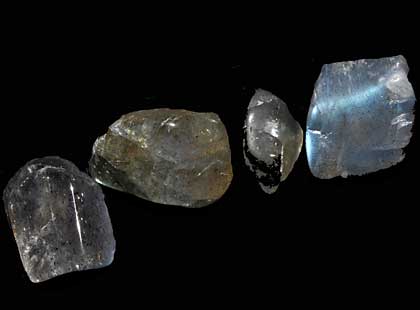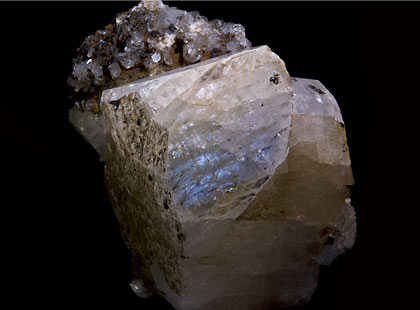Birthstones by the Month
One of the June Birthstones is Moonstone
Moonstone Mineral Form
A member of the large mineral family of feldspars, Moonstone is a sodium potassium aluminosilicate. Tiny albite inclusions mix with orthoclase in alternating layers forming a scale-like structure. This structural pattern causes light interference and scattering. Light enters the gemstone and bounces back and forth between the crystalline formations resulting in the famous inner glow.
Moonstone Facts
Moonstone is the gemstone quality of adularia, named for the European Alps near the Adula Group where it has historically been found. However, Sri Lanka is considered the original country of origin. Moonstone is available in a multitude of colors, but all are distinguished by the playful flashes of light called “adularescence.” The Greeks called Moonstone “selenite” from the word “selene” meaning “moon” since the play of light has been compared to the phases of the moon. Moonstone has been associated with magic throughout its history. In India, Moonstone is considered a holy gemstone and has been referred to as a “dream stone.” Wearing Moonstone while you sleep is said to bring beautiful dreams. Some Arabic countries promote the idea of women sewing Moonstones into garments since the gemstone is recognized as a symbol of fertility. Deposits are found in Australia, Brazil, Madagascar, Mexico, United States and more.
The characteristics of Moonstone
Moonstone forms in multiple colors including grey, brown, orange, blue and more. Rainbow Moonstone contains multiple colors within the same formation. Translucent to transparent in nature, Moonstones have a pearly luster.
Cut and Clarity for the June birthstone
Thin layers of the alternating silicates within the structure of Moonstone typically result in more light refraction with colorful sheen while thicker structures produce white or colorless reflection. There are Moonstones with chatoyancy, also known as cat’s eye. This gemstone is most typically found as cabochons in order to play up the adularescence to its fullest extent. Moonstone beads are also available in a myriad of shapes.
The value of Moonstone
During the Art Deco period, Moonstone was commonly used to adorn jewelry, especially those created by the French goldsmith Rene Lalique. These pieces are most often found in museums now, as their historical and monetary value has gone up. A combination of intense color, large size and high transparency results in higher value for Moonstones. Rare, fine-quality blue Moonstones can display three-dimensional color depth, causing these to have high price tags. Typically, colorful Moonstones from India are more abundant and therefor tend to be a bit more economically priced. Cat eye moonstone, also referred to as “star moonstone,” is also rare and on the more expensive side.
Is Moonstone ever treated?
Moonstone is typically not treated, and only polished after the rough is mined so as not to reduce the surface’s sheen. There are occurrences of blue Moonstone receiving color-enhancing coatings, however.
More about Moonstone the June birthstone
Moonstone has a Mohs hardness of 6 to 6.5, but is sensitive to pressure changes causing the gem to crack or chip. Wear and store Moonstone away from other gemstones, as this gem can be easily scratched. When cleaning Moonstone use a soft cloth and store in a separate soft cloth after ensuring the gemstone or jewelry is fully dry.
The American Gem Society's June Birthstone page has more information to help you buy from knowledgeable and skilled jewelers and to help you make the most informed buying decision.
Image Attribution
- By Parent Géry (Own work) [Public domain] via Wikimedia Commons
- By Didier Descouens (Own work) [CC BY-SA 3.0], via Wikimedia Commons
- By Parent Géry (Own work) [Public domain], via Wikimedia Commons
- By Parent Géry (Own work) [Public domain], via Wikimedia Commons
- By Didier Descouens (Own work) [GFDL or CC BY-SA 3.0], via Wikimedia Commons
